I got more than gasoline that morning
Another advantage in having a Costco close to home is that I can get gas at a good price. On the morning of November 14th I stopped there to do that, and as I was standing outside my car waiting for the tank to fill up I noticed a bird in one of the fruit-laden yaupon trees, Ilex vomitoria, planted nearby along the edge of the property. I happened to have my camera bag with me, so as soon as the tank was full I drove out of the gas station area, parked in a regular parking space, put on my longest lens, and walked back to get close to where the bird had obligingly stayed put. My (uninformed) impression is that this is a mockingbird, Mimus polyglottos, but its lower bill seems unusually short and curved. If any bird bard in the audience can straighten this out—the situation, not the beak—please do so.
© 2014 Steven Schwartzman

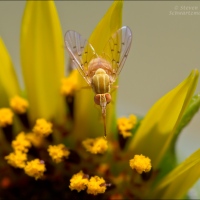
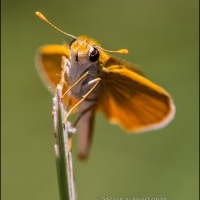
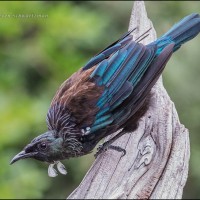
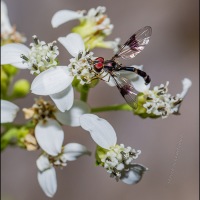
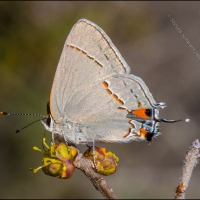
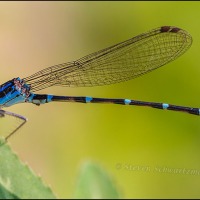

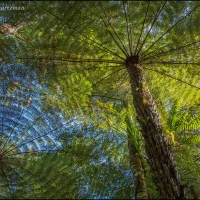

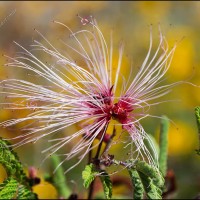
Ilex vomitoria…that sounds unpleasant. Had to look up some info…http://en.wikipedia.org/wiki/Ilex_vomitoria#Cultivation_and_uses
When I was a kid, my older brothers caught a young crow and raised it. It had a broken upper beak. Lost about half of it. It relied on being fed and would have likely died on its own. It was fun to have around.
Sorry, I can’t offer any other beak-bardness than that.
Jim in IA
January 5, 2014 at 7:10 AM
From the article you linked to I learned that there’s a disjunct population of Ilex vomitoria way down in Chiapas, Mexico; perhaps migrating birds carried some yaupon seeds there. And speaking of birds at home, when I was young my mother rescued a young blue jay and kept it for years. As for me, I’ll confess to being more of a beard bard than a bird bard.
Steve Schwartzman
January 5, 2014 at 8:33 AM
Are you adorned with a beard? I am. If so, you must be a fine fellow.
Jim in IA
January 5, 2014 at 8:53 AM
I’ll plead guilty on both counts.
Steve Schwartzman
January 5, 2014 at 8:58 AM
That lower beak does appear to be deformed, but what a cracking image! Can’t help you with the species I’m afraid, we don’t get mocking birds over here.
Heyjude
January 5, 2014 at 7:52 AM
Thanks, Jude, for being the first person ever to describe one of my images as cracking.
Steve Schwartzman
January 5, 2014 at 8:44 AM
😀
Heyjude
January 5, 2014 at 9:54 AM
Beautiful bokeh. Aren’t you glad you had you camera? I have a similar picture that I took after a visit to the dentist. It “almost” made the dental work worthwhile.
norasphotos4u
January 5, 2014 at 10:00 AM
Although it was only the middle of November, the out-of-focus red drupes (fruits) and sun-dappled leaves of the yaupon in the background could almost pass for lights decorating a Christmas tree, such is the transformative power of bokeh. So yes, I’m glad I had my camera gear with me. By coincidence my dentist is interested in photography, so we often talk about that when I’m there. I’d much rather discuss rendition than dentition.
Steve Schwartzman
January 5, 2014 at 10:32 AM
It always pays to have your camera with you. Great shot. 😀
scrapbookingraewyn
January 5, 2014 at 12:21 PM
Thanks. Having the camera with me certainly paid off this time.
Steve Schwartzman
January 5, 2014 at 1:02 PM
There you go … you’ve done it again. What a beautifully arranged shot. How is it that nearly every time you set yourself up to take a photo, a wonderfully complementary background manages to avail itself? Maybe these are artificial and you simply carry them around with you in the trunk of the car and you simply pull out the one which complements each shot the best? Come on Steve, out with it … how do you do this so consistently? If there had been a ‘really like’ button available I would have selected it rather than plain-old ‘like.’ D
Pairodox Farm
January 5, 2014 at 2:00 PM
At least one photographer I’ve met admits to carrying around a false backdrop, but I’ve never done that. I move around a fair amount to try to get a good background behind my subject. I don’t always succeed, but then I don’t show any pictures that didn’t come out at least okay. In the case of today’s photograph, I was using a long lens, so my depth of field was limited; that made it harder to get all the main features of the bird in focus, but at the same time the parts of the yaupon beyond the bird were rendered pleasantly soft.
Steve Schwartzman
January 5, 2014 at 5:06 PM
I’ve seen these beak discrepancies often, and I’m not sure if they may be congenital or were acquired with time. It does look like the Mockingbird to me, also called Nightingales, and I found them not easy to shoot either.
Tropical Flowering Zone/Maria
January 5, 2014 at 3:10 PM
Thanks for letting me know you’ve also seen malformed bird beaks; maybe they’re not so rare (see the next comment). So far no one has suggested this is not a mockingbird, so I may have been right in thinking that it is.
Steve Schwartzman
January 5, 2014 at 5:10 PM
Great photo Steve! Beautiful eyes on the mockingbird 🙂 Great colours in the background too! As others have said, that looks like a malformed beak. I’ve seen it on quite a few garden birds here and they still seem to do ok. Birds and other animals are often much better at adapting to disabilities than people!
Sarah Longes - Mirador Design
January 5, 2014 at 4:32 PM
Thanks, Sarah, for liking the photograph and for confirming that you’ve seen malformed beaks on quite a few birds. It seems to me that a curved lower bill like this one wouldn’t get in the way of eating small fruits like those of the yaupon.
Steve Schwartzman
January 5, 2014 at 5:14 PM
No it shouldn’t be a problem, they have very strong tongues to manipulate seed and fruit. When the rain eventually lets up on us over here I’ll be out photographing our local birds again 🙂 Wonderful creatures to watch!
Sarah Longes - Mirador Design
January 5, 2014 at 5:25 PM
The shrike, which looks remarkably like a mockingbird (albeit with some clearly identifying markings around the head) does have a hooked beak, but it’s the upper portion that’s hooked. As the others have said, this mockingbird’s malformed lower beak isn’t precisely rare, and they can do just fine even with their handicap.
It’s a beautiful photo. The bird looks as though it’s perched in a light-decorated tree.
shoreacres
January 5, 2014 at 6:28 PM
So strike the shrike, mockingbird is the word. This one seemed fine, despite its non-traditional lower beak.
I also had visions of a lighted tree, and by mid-November some earlybirds of the human variety were already beginning to put up outdoor Christmas lights.
Steve Schwartzman
January 5, 2014 at 7:59 PM
Really gorgeous photo Steve! For me the background makes this shot perfect. Great eye for your surroundings to notice the bird!
Michael Glover
January 5, 2014 at 9:34 PM
Thanks, Michael. I agree that the background makes the picture special. I don’t know how much credit I can take for seeing the bird, as it wasn’t all that far away from where I was standing.
Steve Schwartzman
January 5, 2014 at 10:00 PM
I’m no bird expert, but it doesn’t look like a mockingbird to me. I don’t think of them as plump like this one, but on the other hand I’ve never a closeup view like this. The wings would be a giveaway, but we can’t see them in this shot. Of course the songs would settle it too. That’s how I identify them. 🙂
This really is a striking shot. You have a great eye.
Bill
January 6, 2014 at 5:48 AM
I’ve noticed that some birds plump themselves up in the cool morning air, so that might account for what you see here. As for sound, I can’t remember whether this bird made any while I was there, and as for your last sentence, all I can say is that the eyes have it.
Steve Schwartzman
January 6, 2014 at 6:37 AM
So, a mockingbird it is! I’ve not seen a bird yet with a malformed beak. It’s good to know they’re able to “make it” out there in the wide and wild world.
Susan Scheid
January 17, 2014 at 9:59 AM
This one seemed hale and hearty, but I assume that animals with more-serious malformations don’t make it. Medicine, dentistry, and surgery give people great advantages.
Steve Schwartzman
January 17, 2014 at 1:16 PM
With the curved bill, I initially though of the thrasher, but the breast is all wrong. Mockingbird with a deformity it is. I’ve never seen such a thing in the wild. Nutritional deficiency? Damage at a young age? Hm.
Shannon
January 25, 2014 at 8:20 AM
I hadn’t seen anything like that either, but there it was (fortunately for me), and the bird seemed to be none the worse for it. I still don’t know what caused the unusual shape of the lower beak.
Steve Schwartzman
January 25, 2014 at 9:26 AM